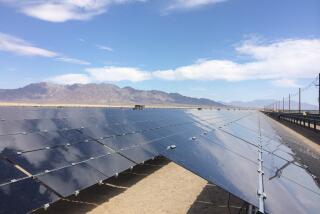No nukes!
SUDDENLY, NUCLEAR power is in vogue. At the G-8 summit in St. Petersburg, Russia, President Bush and Russian President Vladimir V. Putin announced a far-reaching agreement to cooperate in the rapid expansion of nuclear energy worldwide and called on other countries to join them. It was the latest in a series of high-profile initiatives by the White House to promote nuclear power. Bush argues that the future energy security of the United States and the world will depend on increasing reliance on nuclear energy.
A technology that for years suffered ignominiously in scientific purgatory has been resurrected. Its virtues have been heralded by the likes of British Prime Minister Tony Blair, the famed scientist Sir James Lovelock and even a few renegade environmental activists. The nuclear accident at Three Mile Island in Pennsylvania in 1979 and the horrific meltdown at Chernobyl in the former Soviet Union in 1986 have become distant memories. Now, facing rising costs of oil on world markets and real-time global warming, nuclear technology has been given a public relations face-lift and is touted, by some, as the energy of choice in a post-oil era. However, before we let our enthusiasm run away from us, we ought to take a sober look at the consequences of re-nuclearizing the world.
First, nuclear power is unaffordable. With a minimum price tag of $2 billion each, new-generation nuclear power plants are 50% more expensive than putting coal-fired power plants online, and they are far more expensive than new gas-fired power plants. The cost of doubling nuclear power’s share of U.S. electricity generation -- which currently produces 20% of our electricity -- could exceed half a trillion dollars. In a country facing record consumer and government debt, where is the money going to come from? Consumers would pay the price in terms of higher taxes to support government subsidies and higher electricity bills.
Second, 60 years into the nuclear era, our scientists still don’t know how to safely transport, dispose of or store nuclear waste. Spent nuclear rods are piling up all over the world. In the United States, the federal government spent more than $8 billion and 20 years building what was supposed to be an airtight, underground burial tomb dug deep into Yucca Mountain in Nevada to hold radioactive material. The vault was designed to be leak-free for 10,000 years. Unfortunately, the Environmental Protection Agency concedes that the underground storage facility will leak.
Third, according to a study conducted by the International Atomic Energy Agency in 2001, known uranium resources could fail to meet demand, possibly as early as 2026. Of course, new deposits could be discovered, and it is possible that new technological breakthroughs could reduce uranium requirements, but that remains purely speculative.
Fourth, building hundreds of nuclear power plants in an era of spreading Islamic terrorism seems insane. On the one hand the United States, the European Union and much of the world is frightened by the mere possibility that just one country -- Iran -- might use enriched uranium from its nuclear power plants for a nuclear bomb. On the other hand, many of the same governments are eager to spread nuclear power plants around the world, placing them in every nook and cranny of the planet. This means uranium and spent nuclear waste in transit everywhere and piling up in makeshift facilities, often close to heavily populated urban areas.
Nuclear power plants are the ultimate soft target for terrorist attacks. On Nov. 8, 2005, the Australian government arrested 18 suspected Islamic terrorists who were allegedly plotting to blow up Australia’s only nuclear power plant. The U.S. Nuclear Regulatory Commission found that more than half of the nuclear power plants in this country failed to prevent a simulated attack on their facilities. We should all be very worried.
Finally, nuclear power represents the kind of highly centralized, clunky technology of a bygone era. In an age when distributed technologies are undermining hierarchies, decentralizing power and giving rise to networks and open-source economic models, nuclear power seems strangely old-fashioned and obsolete. To a great extent, nuclear power was a Cold War creation. It represented massive concentration of power and reflected the geopolitics of a post-World War II era. Today, however, new technologies are giving people the tools they need to become active participants in an interconnected world. Nuclear power, by contrast, is elite power, controlled by the few. Its resurrection would be a step backward.
Instead, we should pursue an aggressive effort to bring the full range of decentralized renewable technologies online: solar, wind, geothermal, hydro and biomass. And we should establish a hydrogen storage infrastructure to ensure a steady, uninterrupted supply of power for our electricity needs and for transportation.
Our common energy future lies with the sun, not with uranium.
More to Read
Sign up for Essential California
The most important California stories and recommendations in your inbox every morning.
You may occasionally receive promotional content from the Los Angeles Times.









